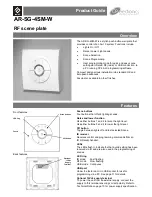Glossary
Clear to Send (CTS)
In flow control, the receiving end is ready and telling the far end to start sending.
Data Terminal Ready (DTR)
A control signal in RS-232 serial communications transmitted from data terminal equipment, such as
a computer, to data communications equipment.
Development Kit (DK)
A hardware development platform used for application development.
General-Purpose Input/Output (GPIO)
A digital signal pin that can be used as input, output, or both. It is uncommitted and can be
controlled by the user at runtime.
Hardware Flow Control (HWFC)
A handshaking mechanism used to prevent an overflow of bytes in modems. It uses two dedicated
pins on the RS-232 connector, Request to Send and Clear to Send.
Integrated Circuit (IC)
A semiconductor chip consisting of fabricated transistors, resistors, and capacitors.
Integrated Development Environment (IDE)
A software application that provides facilities for software development.
Mass Storage Device (MSD)
Any storage device that makes it possible to store and port large amounts of data in a permanent
and machine-readable fashion.
Near Field Communication (NFC)
A standards-based short-range wireless connectivity technology that enables two electronic devices
to establish communication by bringing them close to each other.
NFC-A Listen Mode
Initial mode of an NFC Forum Device when it does not generate a carrier. The device listens for the
remote field of another device. See
Near Field Communication (NFC)
on page 30.
Operational Amplifier (op-amp)
A high-gain voltage amplifier that has a differential input and, usually, a single output.
Printed Circuit Board (PCB)
A board that connects electronic components.
Receive Data (RXD)
A signal line in a serial interface that receives data from another device.
Request to Send (RTS)
4397_500
30


















